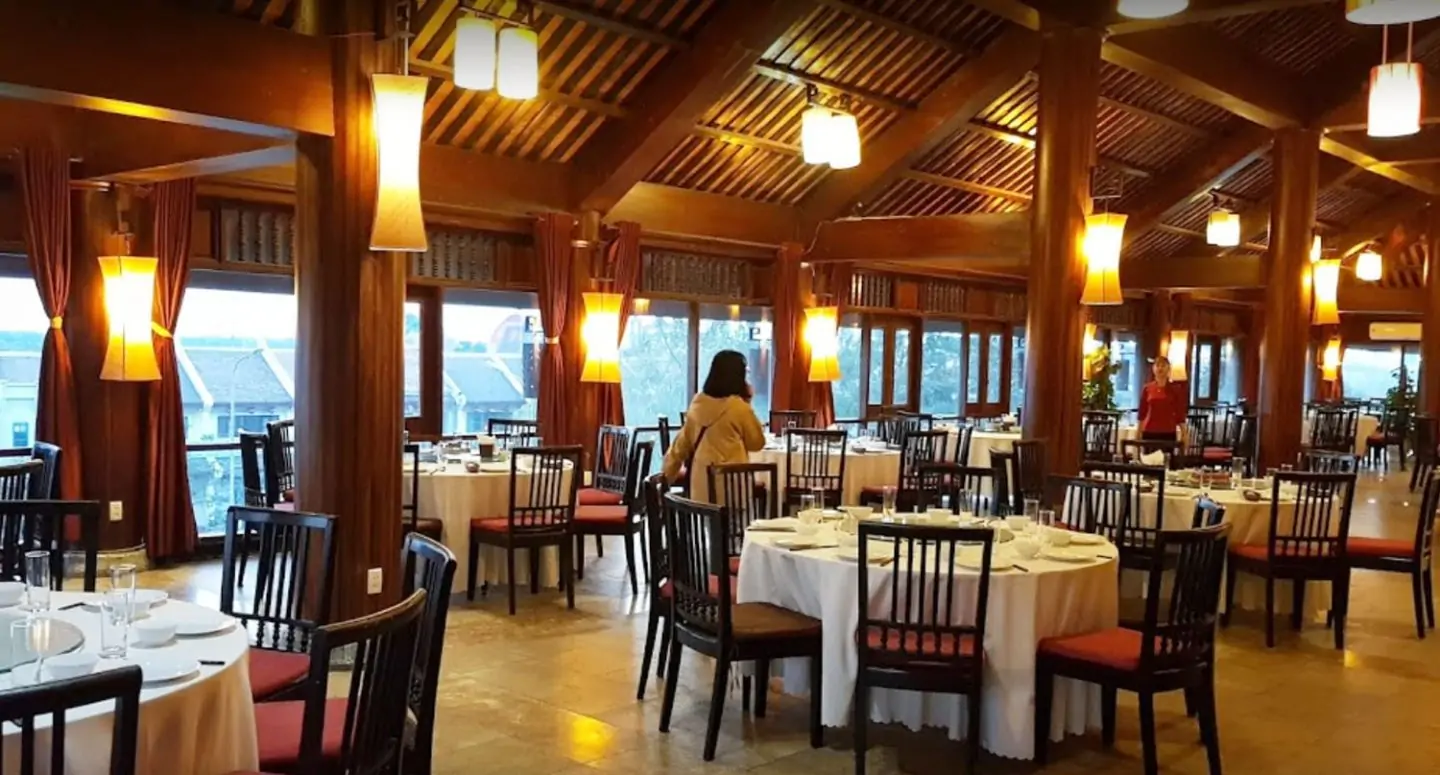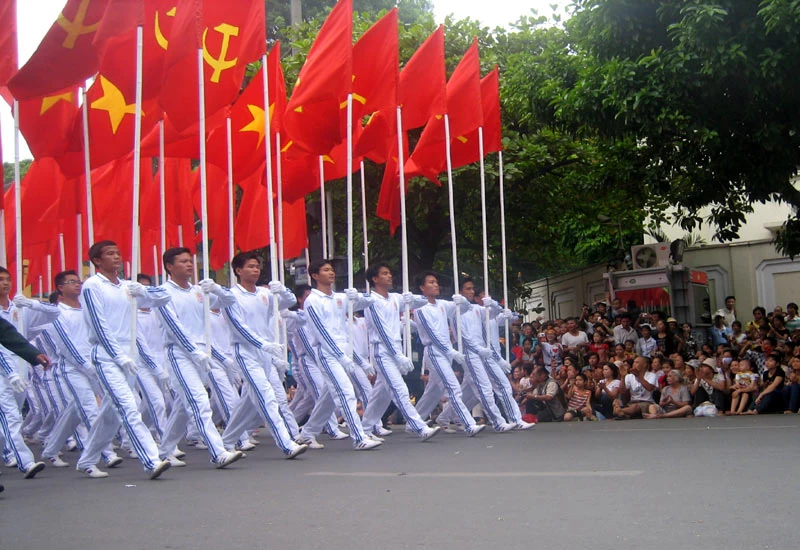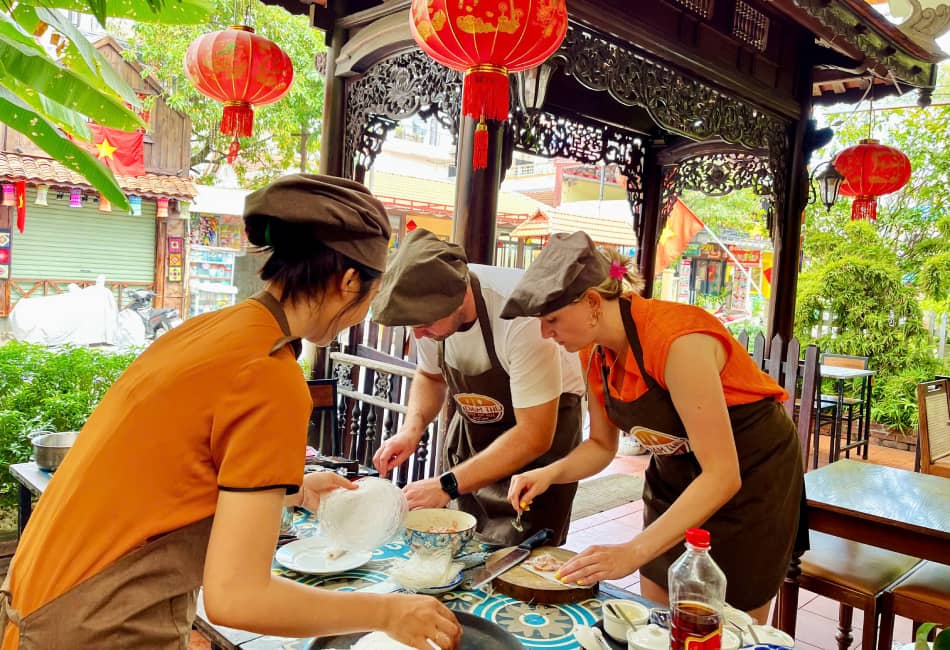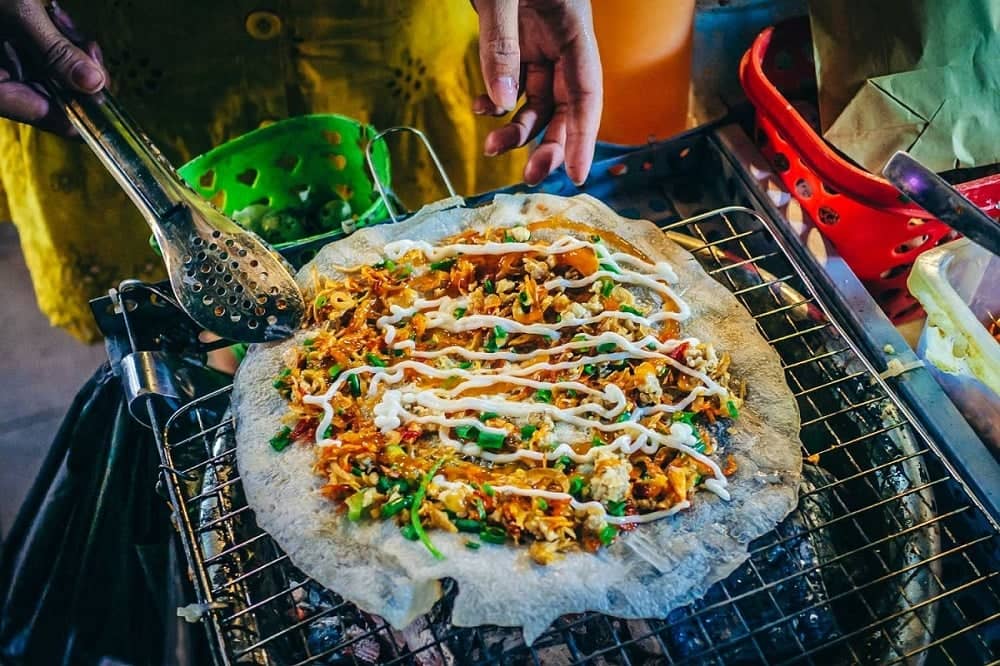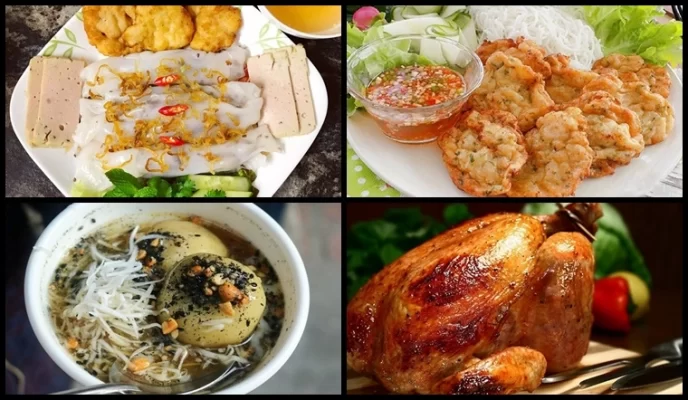
Ha Long cuisine
Ha Long cuisine has its own unique look, combining the flavors of the sea with the essence of this land’s cuisine. With seafood specialties such as squid, shrimp, and sea horseshoe crab, visitors can enjoy delicious dishes rich in sea flavors. At the same time, traditional dishes such as squid patties, shrimp floss, milk oysters, etc. are prepared delicately and creatively, creating a special culinary experience not to be missed when setting foot in this land. Follow Ula Travel now!
1. Squid Patties in Ha Long cuisine
Squid patties are a common delicacy found on the dinner tables of many coastal families. However, not every kitchen can craft these uniquely flavorful patties. The key to making exceptional squid patties lies in using fresh, thick-bodied squid and carefully selecting and preparing other ingredients according to a special recipe. It’s this distinctiveness that has elevated squid patties to a beloved specialty of Ha Long cuisine, cherished by both domestic and international travelers.
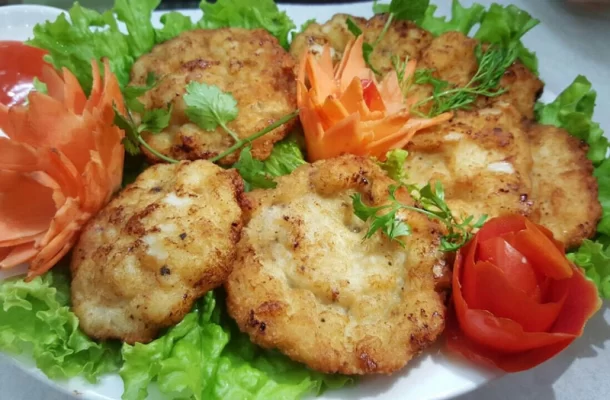
Squid Patties
Ranked among the top 10 best dishes in Asia, squid patties are a source of pride for Ha Long cuisine. When visiting Ha Long, patrons of any eatery are sure to receive a recommendation for this dish. Even from a distance, the tantalizing aroma of the patties cooking in the pan is enough to entice the senses. Each bite reveals the natural golden hue and offers the delightful crunchiness, chewiness, and sweet flavor of fresh squid.
Ha Long squid patties are renowned for their superior taste compared to those from other regions. This is largely due to the sweeter flavor of squid found in Quang Ninh as opposed to squid from the central and southern coastal areas.
What sets these patties apart is the use of Mai squid, distinguished by its thicker body and tiny specks on its skin. Only squid caught in Ha Long Bay can impart such exquisite flavor. The meticulous hand-pressing process used to make these patties ensures that they retain the essence of their deliciousness. Over-pressing the squid results in a dense texture, while under-pressing may lead to a mushy consistency.
The traditional hand-pressed squid patties represent the pinnacle of culinary art in the region. Each bite offers a pure, sweet aroma without any extraneous flavors. To fully savor Ha Long squid patties, they are often enjoyed alongside sticky rice. The aroma of the sticky rice complements the sweetness of the squid meat, creating an immensely satisfying dining experience.
Additionally, visitors can indulge in squid patty rolls, another iconic dish of Ha Long cuisine. These delicate rice rolls, filled with minced meat, fried shallots, and wood ear mushrooms, offer a unique culinary experience when paired with squid patties.
2. Milk oyster porridge
Milk oysters are commonly found in coastal regions throughout the country, but the finest ones come from Ban Sen, harvested in the waters of Van Don, Quang Ninh. These milk oysters are notably large, creamy, aromatic, and packed with valuable nutrients. Milk oyster porridge is a simple and easy-to-enjoy dish of Ha Long cuisine.

Milk oyster porridge
They are utilized in various delicious dishes, such as grilled oysters with scallion oil and oyster cheese, but perhaps the most intriguing and easily enjoyable is milk oyster porridge. This dish combines rice with an assortment of vegetables, such as taro and sweet potatoes, along with the rich, fragrant flavor of milk oysters.
Milk oyster porridge stands out as a specialty of Ha Long cuisine, offering ample vitamins and nutrients while also aiding in the treatment of conditions like hypertension, dizziness, headaches, and diabetes.
Read more: Top 10 Halong Bay Restaurants
3. Hạ Long Yogurt with Tapioca Pearls
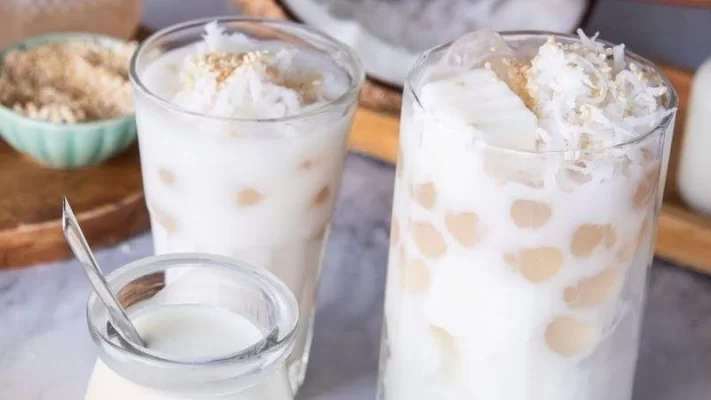
Hạ Long Yogurt with Tapioca Pearls
It’s no coincidence that Hạ Long yogurt with tapioca pearls has become a delicious delicacy, appearing and gaining fame across all regions of the homeland.
This snack is simply prepared but uniquely inspired 100% by the people of Hạ Long, skillfully combining smooth, creamy yogurt with refreshing tapioca pearls and fragrant coconut milk, creating an irresistibly enticing flavor of this dish in Ha Long cuisine. Just one taste is enough to captivate diners and leave them longing for more indefinitely.
4. Peanut Worms
Peanut worms are a rare and prized seafood known for their high nutritional value and numerous health benefits. Historically reserved for royalty, nobility, and the upper class, today they are sought after by many for their health-boosting properties. Today, it has gradually become a popular dish in Ha Long cuisine. Visitors can easily find and enjoy dishes when visiting Ha Long.
These peanut worms typically inhabit coastal sandy areas where tidal movements create sandbanks. Resembling giant earthworms, they lack internal organs like hearts or lungs, with only a straight intestinal tract running from end to end. Harvesting occurs from March to July, but due to high demand, they are often overexploited, leading to a decline in population and increased prices. Peanut worms can be prepared in various delicious ways, including:
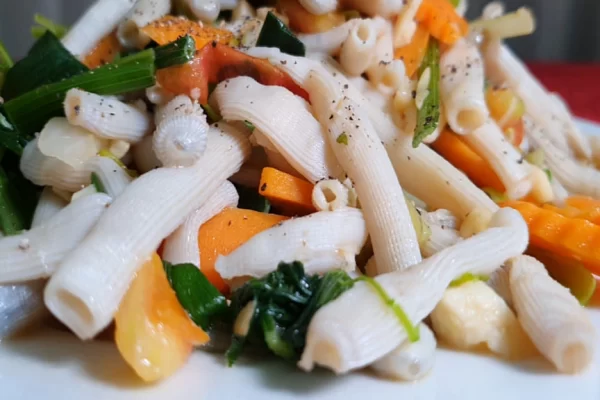
Sweet and sour stir-fried peanut worms
- Sweet and sour stir-fried peanut worms are a flavorful dish rich in nutrients such as amino acids and vitamins.
- Peanut worm noodle soup: a tantalizing twist on traditional noodle soup, with dried peanut worms adding depth to the broth.
- Peanut worm porridge, a nourishing dish ideal for illness recovery, is also valued in traditional Chinese medicine for its health benefits, including replenishing the body, clearing heat, and strengthening overall health.
5. Nodding cake
Nodding cake, a beloved delicacy of Ha Long cuisine, holds a prestigious spot among the must-try sidewalk delights in the region.
Its allure lies in the simple yet delightful blend of flavors: the comforting sweetness of rice flour paired with the tangy kick of fish sauce. Similar to pho cake, nodding cake boasts a chewy texture that sets it apart. In certain eateries, such as those in Tien Yen, it is often savored alongside Ha Long squid rolls, complemented by a side of stitch hump, a stewed pork belly delicacy.
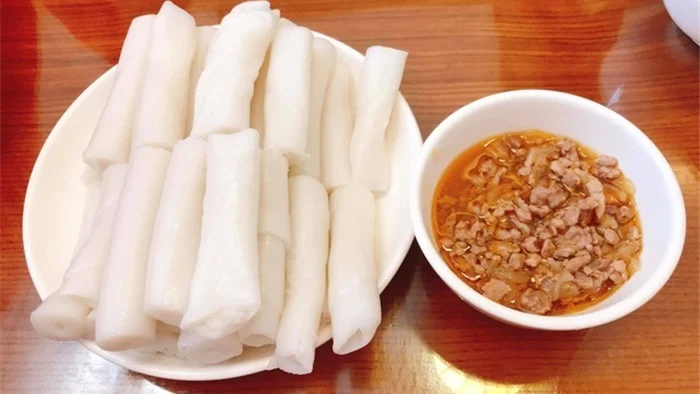
Nodding cake
Thanks to its rice-based composition, nodding cake is suitable for any time of day, whether as a satisfying meal or a quick bite. What further enhances its appeal is its affordability, making it accessible to all diners regardless of budget constraints.
Yet, what truly elevates the experience of nodding cake is its accompanying dipping sauce. This aspect is crucial, as the cake’s flavors are enhanced or subdued based on the quality of the dip and its accompaniments. Typically, the standard dipping sauce is meticulously prepared, featuring a blend of chicken fat, fish sauce, and fried onions.
To enrich the sauce, minced meat is often added, imparting a deeper, more savory taste. However, the true secret behind the sauce’s divine flavor lies in the chicken fat itself. When simmered, it yields a striking golden hue that cannot be replicated by any other fat source.
Nodding cake stands as a delectable treat on its own, but when paired with braised meat, the dipping sauce reaches new heights of richness and flavor, truly capturing the essence of Ha Long cuisine.
Do not miss: Best things to do in Halong Bay
6. Tiên Yên Hill Chicken
When discussing the culinary delights of Ha Long cuisine, one cannot fail to mention the Tiên Yên hill chicken. Situated in the province of Quang Ninh, Tiên Yên district has gained renown for its distinctive hill chicken dish, leaving a lasting impression on countless visitors. Also known as “bearded chicken,” the Tiên Yên hill chicken stands as one of Vietnam’s indigenous poultry breeds.
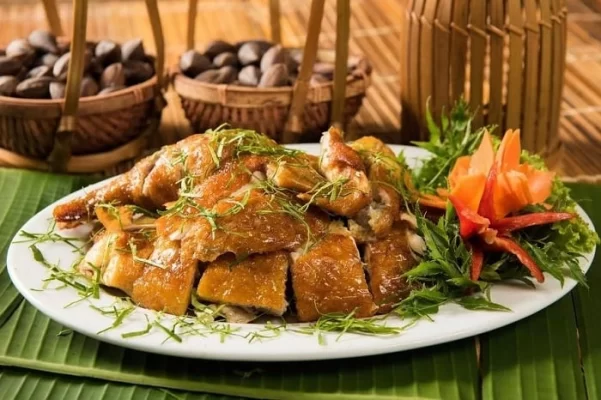
Tiên Yên Hill Chicken
This breed earned the moniker “hill chicken” due to its unique upbringing by local inhabitants. Allowed to roam freely, these chickens spend their days foraging across the hills in search of sustenance before retiring to roost on tree branches at nightfall. This natural lifestyle contributes to the meat’s firm texture and exquisite flavor, compelling those who sample it to crave for more.
Upon indulging in Tiên Yên hill chicken, diners will immediately discern the unique qualities of its meat. Boiled to perfection, the chicken boasts golden-yellow skin and succulent, flavorful flesh that is both tender and crispy.
Notably, Tiên Yên chicken meat lacks the toughness, greasiness, or excessive fat found in other varieties, making it an irresistible culinary delight for all who partake. It would be a mistake if you missed this dish when experiencing Ha Long cuisine.
7. Halong Dried Shrimp Floss
Halong Dried Shrimp Floss stands out as one of the must-try delicacies when exploring the enchanting beauty of Ha Long cuisine. Not only is it a convenient snack, but it also boasts a long shelf life. With its distinctive flavor profile, Halong Dried Shrimp Floss effortlessly appeals to individuals of all ages, from young children to the elderly.
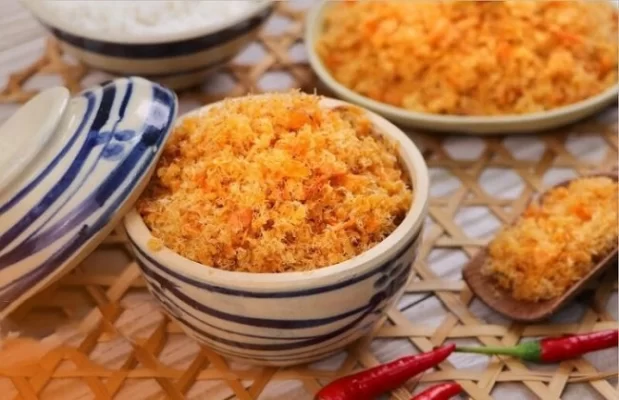
Halong Dried Shrimp Floss
Beyond its rich shrimp taste, this dish harmoniously blends with the sweetness of pork. With its deeply savory and aromatic seaside essence, this Ha Long specialty serves as a valuable gift to present to loved ones and friends during visits to the region.
Halong Dried Shrimp Floss presents an excellent pairing option with a variety of foods, including white rice, sticky rice, porridge, bread, or appetizers. However, the most common and delightful choice remains enjoying it with steaming hot white rice. Just envision a bowl of fragrant rice complemented by the robust flavors of dried shrimp floss—it’s sure to become a staple dish in your culinary repertoire.
8. Hoanh Bo Sticky Rice Wine
Hoanh Bo sticky rice wine stands out as a unique specialty of Ha Long cuisine. With its distinct flavor, this wine has left a lasting impression on countless travelers after their fascinating trips.
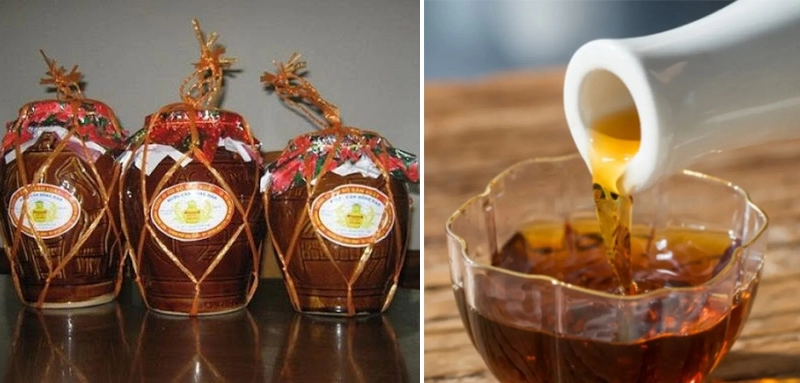
Hoành Bồ Sticky Rice Wine
Hoành Bồ sticky rice wine is the unique beverage that every tourist visiting Halong must taste at least once. It reveals that Ha Long cuisine scene not only boasts delicious dishes but also offers exceptional and distinctive beverages. This wine is crafted from Halong’s specialty sticky rice, fermented with yeast from leaves gathered in the Hoành Bồ forest, hence earning its name as Hoành Bồ sticky rice wine.
This wine is not only refreshing but also aids digestion, making it particularly enjoyable during the summer months. Its uniquely tangy-sweet flavor will captivate you from the very first sip.
Hoành Bồ sticky rice wine features a refreshing, tangy-sweet taste and aids digestion. Rest assured, it’s incredibly easy to drink due to its mild alcohol content, earning it a reputation for being unlikely to cause intoxication.
However, excessive consumption may lead to inevitable intoxication. Sometimes, it might take 2-3 days for one to fully recover from the effects of overindulgence. The advantage of this wine is that upon waking from intoxication, one doesn’t suffer from a hangover and can resume normal activities feeling refreshed, as if they had never been intoxicated the night before.
9. Sea Horseshoe Crab
Sea horseshoe crab is one of the exquisite dishes you must try in Ha long cuisine. It’s a precious and unique seafood delicacy, albeit challenging to prepare and requiring considerable culinary expertise. Sea horseshoe crabs are quite common in the waters of Quang Ninh Province.
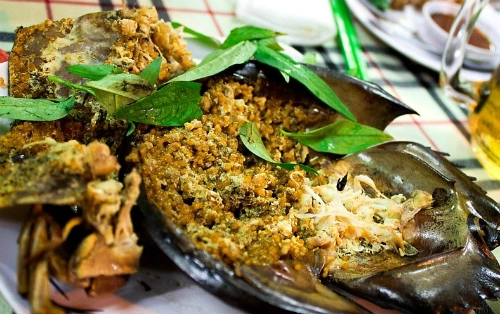
Sea Horseshoe Crab
The preparation of sea cucumber is intricate, demanding years of culinary mastery from chefs. Every part of the sea horseshoe crab, except for its tough outer skin, can be utilized to create various dishes tailored to the diners’ preferences. In Ha Long, with the skillful hands of a chef, a single sea horseshoe crab can yield 7-8 different dishes, such as salads, stir-fries with sour bamboo shoots or betel leaves, or even fried eggs with crispy rice crackers.
Sea horseshoe crab flesh is rich in protein, resembling the texture of abalone but firmer and more subdued in flavor. It’s suitable for stir-frying with spicy condiments like sour bamboo shoots, garlic, chili, or betel leaves. Chefs may also separate the sea horseshoe crab flesh to prepare a sweet and sour salad with spring onions, coriander, basil leaves, sesame seeds, crushed peanuts, and a dash of tangy rice vinegar to counterbalance the richness.
Sea horseshoe crab eggs, known for their creamy texture, are typically fried or grilled and served with crispy rice crackers. Sea Horseshoe crab tentacles are best stir-fried in a sweet and sour sauce made from fish sauce, tamarind, and spicy chili, creating a delightful harmony of flavors.
The sea horseshoe crab’s egg pouch, after removing the eggs, is stuffed with minced meat and rendered lard, then deep-fried until crispy, providing a satisfying crunch. Lastly, the unique dish of sea horseshoe crab sashimi boasts an eye-catching blue hue and a refreshing, sweet flavor.
10. Tai long ep Cake
Tai long ep Cake is also commonly known as Lucky Cake. It is regarded as a specialty of the Sán Dìu people in Quang Ninh. The Sán Dìu ethnic community predominantly resides in cities such as Ha Long, Cam Pha, and Van Don, as well as scattered across various northern mountainous provinces. Tai long ep Cake, much like other traditional dishes of the Sán Dìu, is cherished for its rustic appeal, ease of consumption, and delectable taste.
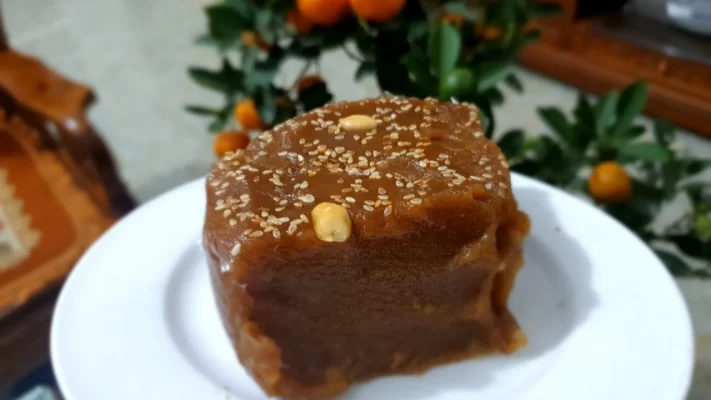
Tai long ep Cake
Tai long ep Cake, crafted from a blend of ingredients including glutinous rice flour, granulated sugar or cane sugar, crushed ginger juice, peanuts, and toasted sesame seeds, exudes a brownish-yellow hue once cooked. Adorning its surface is a generous layer of evenly scattered peanuts and sesame seeds, enhancing its visual allure. Boasting the chewiness of glutinous rice and the tantalizing fragrance of ginger, coupled with the rich nuttiness of peanuts and sesame seeds, the Tai long ep Cake offers a delightful symphony of flavors.
The meticulous process of crafting Tai long ep Cake involves several intricate steps. Initially, glutinous rice flour is finely ground and mixed with granulated sugar. Subsequently, the dough is kneaded until it achieves a smooth, non-sticky consistency before being pressed into a mold lined with banana leaves and spread thinly to a thickness of approximately 5 millimeters.
Next, the cake is topped with a layer of banana leaves and a sprinkle of toasted sesame seeds. It is then steamed in a steamer that has been filled with granulated sugar. This steaming process is time-intensive, typically spanning around 8 hours to yield a soft, fragrant cake.
For optimal enjoyment, Tai long ep Cake is best savored once cooled to prevent overwhelming sensations, offering a uniquely delightful taste without excessive sweetness. It is advisable to allow the cake to firm up overnight before slicing it into pieces to relish its freshness. In addition to being enjoyed as is, this cake can also be sliced into thin pieces after a few days, then pan-fried until achieving a golden-brown crust, presenting yet another delightful culinary experience.
See more: Halong Bay Travel tips







